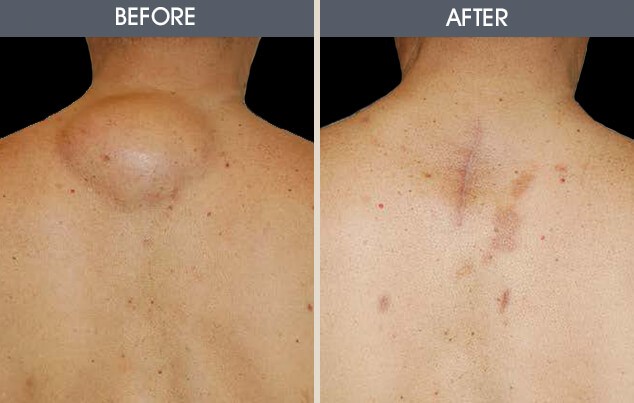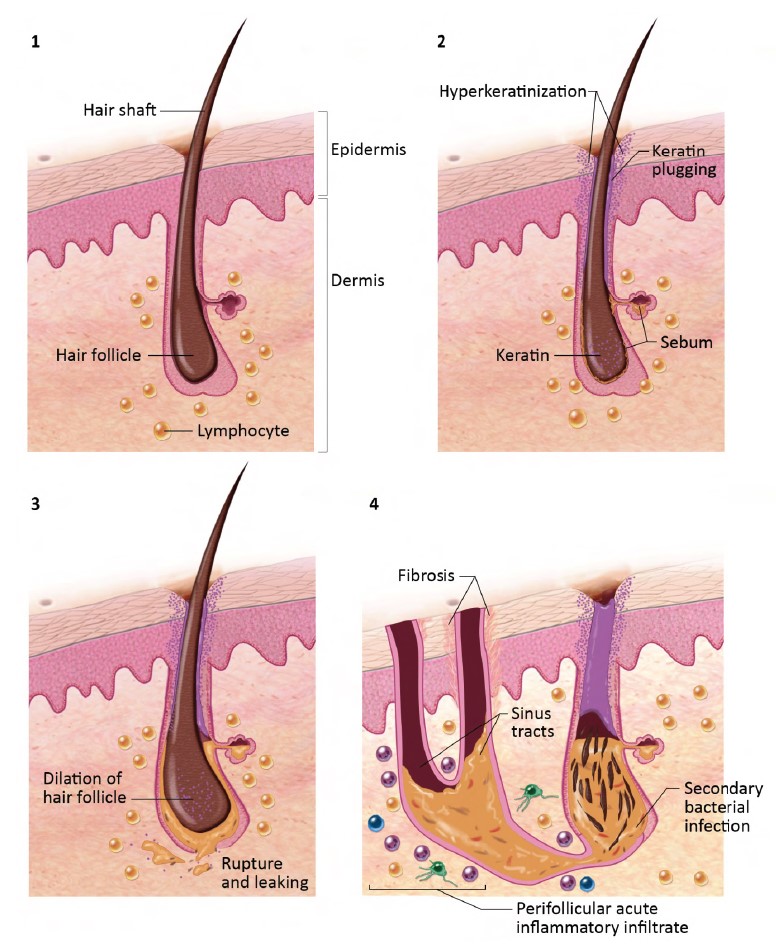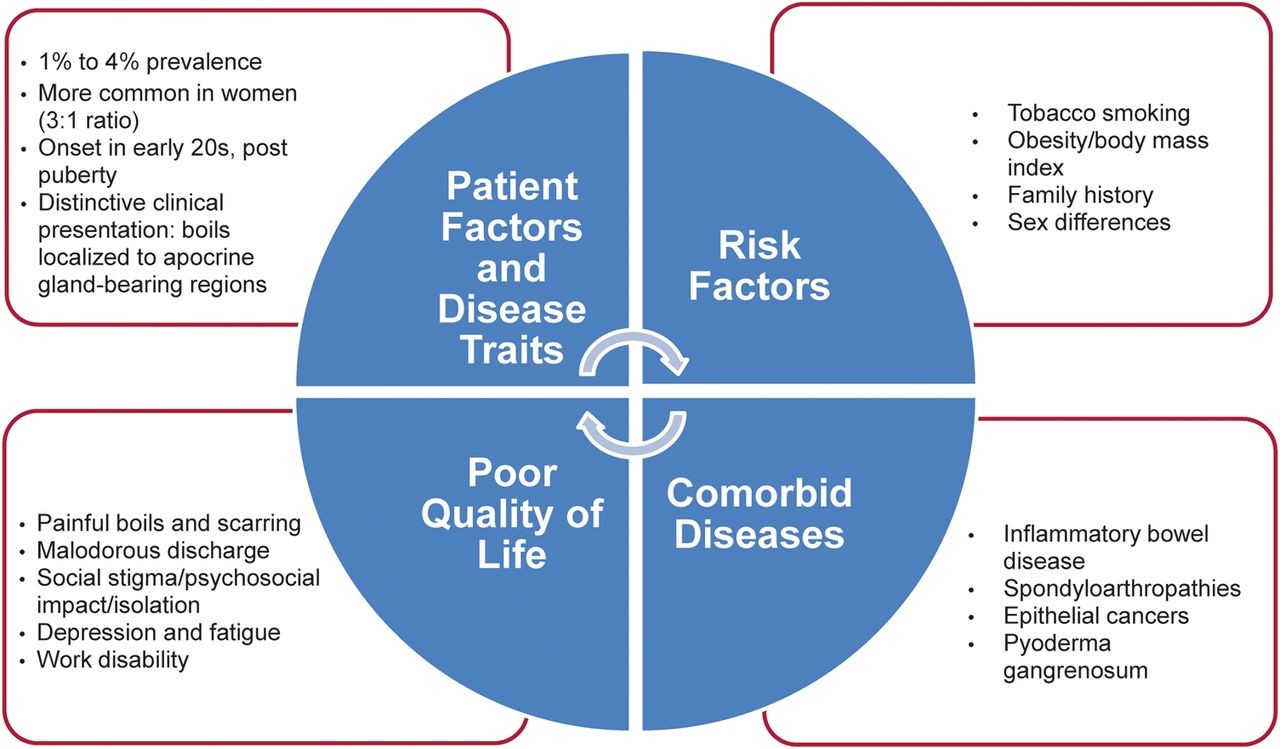Hidradinitis
Hidradenitis suppurativa is a long-term (chronic) skin condition. The cause is unknown. Inflammation of the apocrine sweat gland-bearing areas leads to painful and recurrent boils and abscesses. An abscess is a collection of pus. Suppuration means formation or discharge of pus. These areas (commonly the armpits and groin) leak pus and are difficult to heal. Eventually, scarring occurs. Treatments include antibiotic medicines, surgical drainage of the abscesses and, sometimes, surgical removal of the affected skin areas.

Skin and sweat glands
There are two different types of sweat gland in the skin on the human body. These are:
Apocrine sweat glands.
Eccrine (or merocrine) sweat glands.
Apocrine sweat glands
These are larger than the eccrine sweat glands, and found only in the skin on certain areas of the body. These areas include the underarms (axillae); under the breasts and around the nipples; and in the groin and genital region.
The main difference between apocrine and the more common eccrine sweat glands is that apocrine glands release their fluid (secretions) into the hair follicles, rather than directly on to the skin. The secretions are a thick, milky fluid, which can easily be turned into smelly body odour by germs (bacteria). The secretions from apocrine glands do not appear to have any specific function. It contains pheromones which are chemicals that are supposed to help humans find a mate!
The apocrine glands only start working at puberty, due to the action of the hormone changes that occur at this time.
Eccrine (merocrine) sweat glands
There are many more of these smaller sweat glands. They are found all over the body, with the largest numbers being found on the palms of the hands, the soles of the feet, and the forehead.
These sweat glands release sweat directly on to the skin surface through pores. They are located in the skin, but not as deep as the apocrine glands. This sweat is watery and clear, and contains various salts, and other waste chemicals the body needs to get rid of. The sweat helps to cool us down and is also secreted as an emotional response – for example, when anxious or stressed.
The nervous system controls both types of sweat glands. However, each type responds via different nerve fibres and different chemical messengers (neurotransmitters).
Understanding hidradenitis suppurativa
Hidradenitis suppurativa is a long-term (chronic) inflammatory skin disease with recurrent boil-like lumps. These boils often get bigger, and turn into collections of pus (abscesses). The abscesses leak pus and become difficult to heal.
The problem affects only areas of the skin containing apocrine sweat glands.
Commonly, the problem affects the groin and armpits. Other areas are sometimes affected such as under the breasts, the vulva, the scrotum, the buttocks and the perineum. (The perineum is the area of skin between the anus and, either the vulva in a woman, or the scrotum, in a man.) Women tend to develop it more commonly in the armpits, groin and under the breasts. Men more commonly develop disease that affects the perineal and perianal (around the anus) skin.
The wounds caused by the boils and abscesses heal poorly with scarring. In severe cases, the pus tunnels down under the skin surface. The tunnels (channels) formed are called sinus tracts. Multiple areas of hidradenitis can become linked under the skin surface, by a network of interconnected sinus tracts. This means the inflammation (and sometimes infection) travels deeper and becomes more widespread.
The eventually healed areas are full of thick scar tissue. The scarring can be as unsightly as the discharging wounds themselves.
Is hidradenitis suppurativa known by any other names?
Hidradenitis suppurativa is known by several other names, which can cause confusion. These are:
Acne inversa
Apocrine acne
Acne conglobata
Verneuil’s disease
Apocrinitis
Velpeau’s disease
What causes hidradenitis suppurativa?
The cause is not well understood. It is thought to happen due to blockage of the hair follicles on the skin, or the sweat gland openings themselves. This blockage could be from sweat itself, or skin secretions, such as sebum from the sebaceous glands. The blocked sweat gland continues to make sweat. The sweat cannot escape on to the skin surface and so is forced deeper into surrounding tissue. Germs (bacteria) that normally live on the skin surface may have been trapped in the blocked gland or hair follicle. The bacteria can multiply in warm moist surroundings. As the sweat is forced back deeper into the tissues, it takes with it the bacteria. This leads to inflammation, and sometimes infection. This is how the hard boil-like lumps are thought to form to start with. As the problem gets worse, abscesses, which contain pus, develop.
It may also be that the sweat glands in some people don’t develop correctly and completely. These glands might not allow the sweat they make to reach the skin surface. Instead, the sweat is trapped and travels into the surrounding tissues.

Proneness to hidradenitis suppurativa
It is quite common. Many people will have very mild problems with it.
Hidradenitis suppurativa usually affects people between puberty and middle age. It is three times more common in women than in men. It is rare in Asian people, and far more common in Caucasians (white-skinned people) or Afro-Caribbean people.
Hidradenitis suppurativa only develops after puberty. This is because the sweat glands are activated by hormones called sex hormones, the levels of which increase during puberty. The problem tends to improve for women if they take the combined oral contraceptive pill (COCP) – the ‘Pill’, or if they are pregnant. It rarely occurs after the menopause. These things all suggest that hormones play a part in causing this disease.
The disease can run in families (about 1 in 3 cases) but the exact pattern of inheritance is not known.
Hidradenitis suppurativa is more common in obese people and in cigarette smokers. Obesity and smoking are not direct causes. However, they can be thought of as risk factors. Hidradenitis suppurativa also seems more common in people with acne and hirsutism (excessive abnormal hairiness, especially in women).

What are the signs and symptoms of hidradenitis suppurativa?
Hidradenitis suppurativa usually starts with a single inflamed, boil-like, firm, raised skin lump (nodule). Sometimes this stage can result in itching, but usually there is discomfort.
The nodule either slowly disappears (between 10 and 30 days) or remains (persists) to become a draining (suppurative) collection of pus (abscess). Abscesses are usually very painful.
Eventually, healing occurs but the affected skin is permanently affected, leaving deep scarring. In more severe disease the affected areas spread. Either single or multiple abscesses occur. The formation of tunnels (channels), called sinus tracts, causes the overlying skin to feel hard and lumpy (indurated).
A staging system (Hurley’s staging) can be used to describe the severity of the disease:
Stage 1 – here there are either single or multiple areas affected, but the abscesses are separate from one another. There is no scarring or sinus tract formation.
Stage 2 – involves recurrent abscesses, which can be single or multiple. Although there are sinus tracts, the affected areas are usually widely separated.
Stage 3 – generally, large areas are affected with multiple interconnected sinus tracts and abscesses.
For some people, the disease is extremely distressing; with a constant succession of new nodules and abscesses forming as soon as older ones have finally healed.
Need of investigations to detect hidradenitis suppurativa
There are no tests used to diagnose hidradenitis suppurativa. The diagnosis is usually based on the typical signs and symptoms that a person may have.
Sometimes hidradenitis suppurativa is confused with other similar-looking skin conditions such as common boils, collections of pus (abscesses), skin infections and ingrowing hairs. Other diseases can cause tunnels (channels) known as sinus tracts – for example, Crohn’s disease. Tests might be needed to exclude these other conditions, though they often have many other symptoms.
Sometimes, if there are signs of infection, small samples (swabs) can be taken. This is to see what germs (bacteria) are growing in the pus. This can help in deciding whether antibiotic medicines (and which ones) should be used.
Occasionally, it might be helpful to test one’s blood for sugar (glucose) to make sure one do not have diabetes. This is because skin infections are more common in people with diabetes. One’s doctor might also take blood to make sure the person not anaemic and to monitor the level of infection or inflammation.
Scans, such as CT scans, are not needed to diagnose the condition. They may, however, be used in very severe disease, to plan surgery, as it is important to know where the sinus tracts go, and how deep they are.
Therapeutics for hidradenitis suppurativa
General advice
One must try to lose weight if one is obese and stop smoking if one smokes.
Also, the following may help relieve some of your symptoms:
loose-fitting cotton clothing should be worn.
The affected areas should be washed carefully and gently, preferably using an antibacterial or antiseptic soap or shower gel. This is to try to get rid of germs (bacteria) on the skin. (Note: it is normal to have bacteria harmlessly living on the skin.)
Shaving of affected areas, such as the underarms, should be avoided.
Use of deodorants and antiperspirants should also be avoided if the underarms are affected, and perfumes should be avoided too on affected areas .
One can use a hot flannel (as hot as one can bear), to hold against affected areas and encourage the collections of pus (abscesses) to come to a ‘point’, so that they start draining. A tense hard abscess that has not burst is more painful than one where the pus is draining out.
Heat exposure and sweating should be avoided. This might mean avoiding sitting next to the fireplace, or avoiding intense exercise in the gym.
Medical treatment
It is difficult to control hidradenitis suppurativa with medical treatment. The aim is to catch the disease in its early stages, and treat and control milder forms of the disease. Medical treatment means using medicines, either on the skin (topically), or by mouth. Examples of medical treatment include:
Topical anti-acne antibiotic and benzoyl peroxide. The antibiotics kill bacteria on the skin whilst the benzoyl peroxide is an antibacterial agent and also leads to drying of the skin. Benzoyl peroxide also encourages the skin to shed its dead surface, which can help stop the blockage of pores.
Short courses of antibiotic tablets can be used when there are new abscesses. The aim is to try to stop the infection from spreading and to help the abscess heal more quickly. Generally a short course of antibiotics will last for two weeks.
Prolonged courses of antibiotic tablets. These are usually used for their anti-inflammatory action.
Trial of the COCP (the pill) can be used. A trial of up to 12 months may be needed before deciding whether the skin has improved. Some COCPs might be better than others. They counteract some of the more ‘male’ hormone effects such as skin oiliness and spots. Contraceptive pills are, of course, only suitable for women. Not all women can safely use the Pill, as contraceptive pills can have serious side-effects in some women. One’s doctor can suggest whether it is safe to use the Pill.
Retinoids. Acitretin is a retinoid, which has shown promising results. It may be used when other medicines have not been helpful. These are vitamin A-based medicines and should only be prescribed by specialist.
These medicines work by stopping the secretion of sebum from sebaceous glands. They also help the normal shedding of dead skin cells in the hair follicles, preventing pore blockage. It must not be taken in pregnancy due to the risk of birth defects.
Corticosteroid tablets (steroids), such as prednisolone, may be used in short courses to reduce inflammation. Long courses of steroids can cause serious side-effects such as ‘thinning’ of the bones (osteoporosis), weight gain, high blood pressure, cataracts and mental health problems
Medicines that affect the immune system have been used with some success. These medicines can only be prescribed by a specialist (such as a dermatologist) and your treatment must be carefully monitored. This is because there are potentially very serious side-effects such as kidney (renal) failure, and low blood counts (which can make you at risk of an overwhelming infection). Examples of medicines used are:
Anti-TNF medicines such as infliximab, Dapsone(usually used to treat leprosy; used in hidradenitis suppurativa for its anti-inflammatory action).
Surgical treatment
Long-standing hidradenitis suppurativa usually requires Hidradenitis suppurativa Treatment/Hidradenitis suppurativa surgery. Generally, Hidradenitis suppurativa Treatment/Hidradenitis suppurativa surgery would be performed under general anaesthetic. The Hidradenitis suppurativa Treatment/Hidradenitis suppurativa surgery chosen depends on the grade or extent of the hidradenitis suppurativa. Hidradenitis suppurativa Treatment/Hidradenitis suppurativa surgery treatments include:
Incision and drainage – Hidradenitis suppurativa Treatment/Hidradenitis suppurativa surgery means piercing (lancing) a tense, hard abscess and allowing the pus to drain out. This is most appropriate for grade 1 hidradenitis suppurativa, and a course of antibiotic tablets would usually be given afterwards.
Wide-scale removal (excision) of affected areas –Hidradenitis suppurativa Treatment/Hidradenitis suppurativa surgery can be used for grade 2 and 3 disease. Forstage 2 disease, the sinus tracts are surgically removed. In stage 3 disease, the operation needs to be more extensive, as the tracts and scarring go deeper and larger areas are involved. This means a lot of scarred, infected tissue has to be removed. Often skin grafts and other plastic surgery techniques are needed.
Carbon dioxide laser treatment can be used as an alternative to conventional surgery, where available, and dependent on the severity of the disease. It is quite a new treatment. The diseased tissue is ‘vapourised’ leaving an open wound which is left to heal. Admission to hospital overnight is not normally needed.
Other treatments
Radiotherapy has been used to treat hidradenitis suppurativa, but this is not common.
Complexities from having hidradenitis suppurativa
The main complication is scarring of the skin and deeper tissues. In severe cases, this can cause swelling of the arm (if the armpit was affected) or of the leg (if the groin was affected). This is called lymphoedema. This means that the fluid (lymph) drainage from the limb is affected and the fluid builds up, causing the swelling. It is a difficult problem to treat and cure; often, tight elastic compression garments have to be worn long-term.
Other complications include:
A general feeling of being unwell and tired (malaise).
Depression.
Long-term (chronic) infection leading to problems such as anaemia, kidney failure and low levels of protein in the blood.
Joint pains and inflammation (arthropathy).
Skin cancer. This is very rare and has been reported in very severe long-term hidradenitis suppurativa.
Fistula formation. A fistula occurs when channels, called sinus tracts, tunnel into other parts of the body, such as the bowel or bladder (this is extremely rare).
Prognosis
The prognosis is very variable. Not everyone progresses from stage 1 to stage 3.
For many affected people, hidradenitis suppurativa is a painful and debilitating condition. It has a tendency to flare up regularly, gradually causing more problems. Deep scarring and formation of tunnels (channels), called sinus tracts, are not uncommon.
Some people have mild (stage 1) disease only. Early surgical treatment can (in some cases) cure the disease and stop it from returning. In rare cases, the condition goes away on its own without treatment.
Hidradenitis suppurativa is seldom a fatal condition unless there is an overwhelming infection in an immunocompromised person (that is, someone with an abnormal immune system).
The condition can prevent normal working and social activities (for example, swimming). Psychological problems are common, as are difficulties in relationships. These problems can either be directly due to the pain and messiness of the condition or to embarrassment and body image problems.